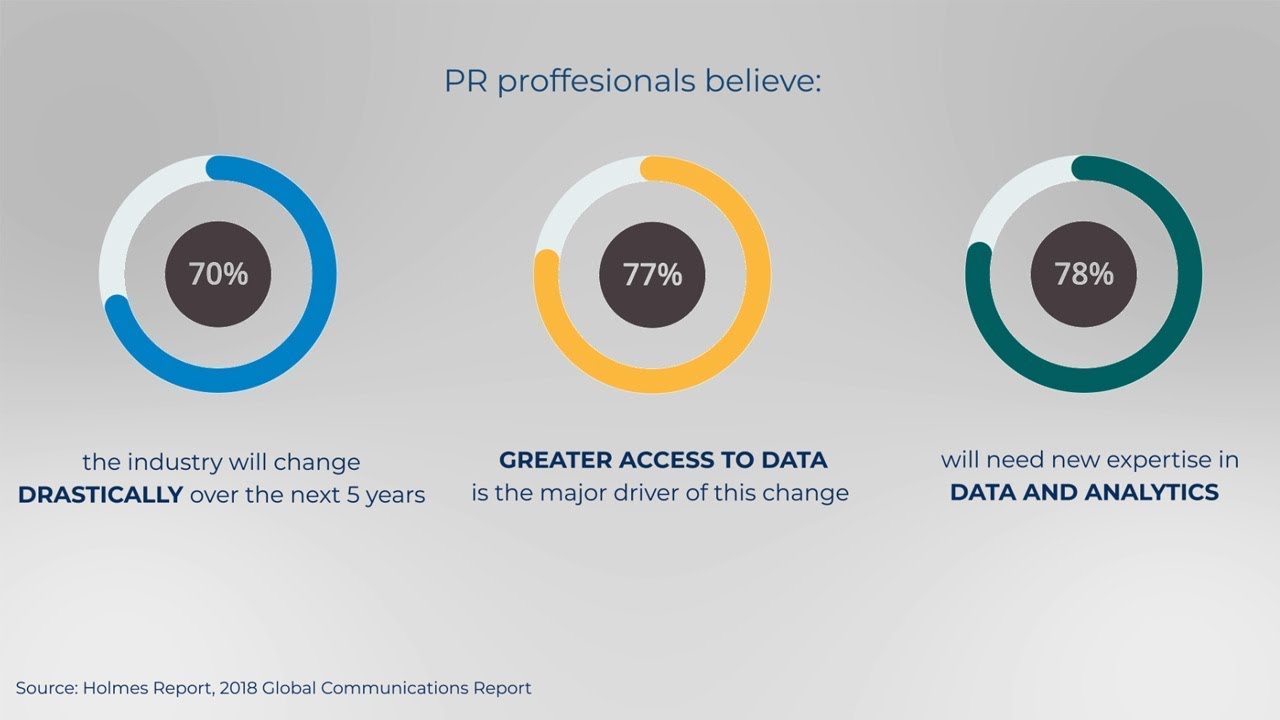Does PR work? When a company has to spend thousands of dollars on public relations, this is a question they often ask.
This blog post has all the information you need about PR metrics how to measure public relations. The text will answer both basic and more advanced questions, starting with why you should measure the results of a PR campaign and ending with which PR metrics you should follow and why.
It's true that the benefits of public relations can be harder to track than the benefits of advertising or other marketing methods. But that doesn't mean businesses should give up on PR and stick to more traditional ways of advertising.
What Is PR Measurement?
It's important to be able to measure your success so you can set goals for growth and make good decisions. But while data analysis has become popular in other fields, Public Relations (PR) has been slow to follow suit.
Part of the problem is that PR deals with things that don't seem real, like support and how customers feel. One study found that more than 80% of companies say they don't have the right tools to measure the return on investment (ROI) of their PR efforts.
There is a lot of technology out there today that can give us useful information. PR Measurement is the process of keeping track of the results of PR efforts and writing down the businessresults of a campaign. It gives concrete, measurable numbers to even vague things like how people feel.
Why Measuring PR Is Important?

The importance of PR measurement
It is important but not easy to figure out how tomeasure the value of PR and link your strategy to your businessgoals.
Simply put, you need to make sure that both your internal and external investments are worth it. When your PR program is a driver of business and revenue instead of a cost center, you can keep growing, trying new things, and investing to make a bigger difference.
At a deeper level, markets are very noisy and full of competition. Just doing PRisn’t enough. Generating coverage, winning a few awards, and issuing press releases are also not enough. PR needs to be a part of something bigger, and it needs to be measured against your competitors and the market opportunity.
For instance, the most advanced programs compare their results to those of their rivals. To win business and build market preference, you need to do more than just make people aware of you. You also need to set yourself apart and get more exposure than your competitors.
If PR is responsible for 10% of annual growth, but the market is growing at 40%, it's clear that something is wrong. And your PR program might be part of the problem (but probably not the only problem).
Getting ahead in your careeralso requires you to measure things. PR can be hard to understand if you don't work in the field every day. Hard data makes it easier to see why what you do is important and why you should get more chances.
PR can't always stand on its own. And that's fine as well. It's understandable that attribution is hard for many PR professionals. How you talk about public relations and how you think about measuring are very important.
For example, it's more important to show how PR helps your business grow as part of a larger, more integrated strategy than to measure the specific effect of a single PR effort. Build your framework for measuring, and then set your expectations based on that.
The Benefits Of Tracking PR Metrics
When you track the right public relations metrics, you can get a detailed look at what you're doing and why it's working or not working. This can be a big part of showing how important what you're already doing is. It can also help you find answers to:
- Are you talking to the right people? What are they doing about it?
- What kind of media attention do your campaigns get?
- What is the real business impact or return on investment (ROI) of PR work?
- How can campaigns work better in the future?
In addition to planning better campaigns for the future, it is sometimes possible to make small changes to campaigns that are already running to make them more effective and increase ROI.
The information you learn from analyzing PR campaign data can also help you in other ways, like giving you information about your audience and demographics in case you have to deal with a crisis in relations in the future.
Which PR Metrics To Measure?
Finding the right metrics to use is often the hardest part for PR pros who want to start a data-driven strategy. In fact, one study found that two of the main reasons PR professionals don't measure their results are that they don't know how to measure or feel like metrics don't have enough standards.
The right PR measurement metrics to use depend on your end goal, the size of your audience, and the PR campaigns you are running at the moment. So, here is a list of some things that are often helpful for judging the success of PR:
Website-Based Metrics

5 Basic Website Metrics Everyone Should Know | Two Minute Tuesdays
Digital Traffic
If no one sees what you put out there, nothing else matters. Viewers are the most important metric for a reason. You can (and should) also get more specific. For example, what kind of contentdoes best, and where is it? How do the metrics for social content, your blog, and other content compare to each other? This information should be given by most analytics programs.
Website Referrals
Referralsshow you where your views are coming from, which can be more useful than just knowing how many people are looking at your site. Referrals let you figure out what kind of approach brings in the most people and where they are most likely to find your content and follow it to your site.
Conversions
PR and marketing campaigns often have as their main goal increasing sales. The most obvious way to measure success in this area is to see how many people become customers after seeing your campaign.
Bounce Rate
If people leave your site as soon as they get there, that could mean you're not doing enough to keep them there. If you know how people usually move around your site, you can plan and group content in a way that makes sense.
Domain Authority
How Google ranks you in search depends a lot on how trustworthy your domain is. Some of the things that determine domain authorityare out of your control, like how old your domain is. Backlinksand outgoing links also play a role, so it can be important to track your domain authority over time.
Backlinks
How many other websites link to your content or site? What kind of talk is there about your brand? How big are they, and how much power do they have?
Qualified Leads
How many of the people you reach are really interested in buying something in the future?
Revenue
Even though it can be hard to prove a direct link between PR campaigns and revenue, a small business's bottom line can be an objective sign that a campaign is working.
Social Media And Awareness
Social Media Mentions And Sentiment
How many people talk about your brand on social mediawithout you telling them to? What this means is, who is talking about you and what are they saying?
The tone of these mentions can be more important than the mentions themselves. Many modern tools let you measure whether the talking points are positive or negative, which can be very helpful when tracking a brand's reputation over time.
Engagement
The number of people who talk with you is another way to figure out how important your content is on social networking sites. Likes, shares, comments, follows, and subscribers are all ways to find out how engaged your audience is with your brand.
Share Of Voice (SOV)
Share of Voice compares how much airtime your brand gets to how much other brands in your industry get. If most of the time when people talk about your industry, they don't talk about your business in particular, you might want to change how you do things to stand out more.
PR Metrics - How To Measure Public Relations?

How to measure public relations
Track Your Web Traffic With Google Analytics
Google Analyticsis a tool that lets you track how many people visit your website and where they come from. It can tell you a lot about how a PR campaign affects your website's visibility.
With Google Analytics, you can find out if you're getting more site visits, unique visitors, and conversions than you were before your PR campaign started.
If you write a guest post, for example, the site where it is posted may send more people to your site. Or, if a local newspaper wrote about you, their website or search terms related to the article may have led people to your site. With this data, you can figure out how much your PR work helped.
Talk To Your New Business Leads
Talking to your new customers, clients, or supporters is always a good idea. It's good for public relations and a good way to find out how they heard about you. This will help you figure out if new interest and sales are coming from recent campaigns.
Small businesses often depend on having real relationships with other people. So, putting in the time and effort to find out how someone found you shows that you appreciate their support.
This kind of qualitative research can help you figure out how well your campaigns are doing and might also give you some surprising information about what your audience wants.
Analyze Your Success With Press
It's important to keep track of how people respond to your pitches and press releases. You might want to make a spreadsheet and add information about each person you talk to. Keep the following in mind:
- Who did you contact? (What e-mail address did you use?)
- Did you get a response? Did they say so?
- If they didn't like your pitch, did they tell you what they would have liked instead?
- Did the press write about your efforts?
- If you did get coverage, did it lead to any new business?
You can do a few things better if you keep an eye on this information. First, it will be easier to figure out who you should get in touch with in the future. It will also help you figure out what your best pitches and press releases have in common. Then, you can use what you've learned to help you get more responses in the future.
Measure Engagement With Your Social Media
Public relations and using social media go hand in hand. You could use social media to share news, find new customers, and spread the word about what you do. You can also check how well your campaigns are doing by using your social channels.
Make sure to use the tools that each channel gives you to see how many people are reading your posts and how your network is growing. You might also want to think about using social sentiment software to help you track and analyze tags, mentions, likes, and shares about your business.
Before and after a PR campaign, you should take these measurements to see if it has any effect and to figure out what that effect is.
See What PR Does For Your Sales
Sales are often the most important measure for a business. One way to see how PR affects sales is to give everyone who sees your campaign a discount code or coupon.
PR efforts like these should lead to more sales, if all goes well. But if you don't see any change after a campaign, you might want to look at your strategies again or try something different next time.
Track Your Email Audience Growth And Engagement
How To Track Emails for Free | Top 3 Email Tracking Tools for Small Business
Your email list will grow, which is another good thing that will come out of your PR campaigns. When you're making your campaigns, make sure they lead people straight to your website (or landing page), where they can easily sign up for your email list using a signup form or pop-up.
As people start to get your emails and respond to them, they'll give you valuable information about them. With each email, you'll learn more about a person's preferences, how they interact with content, and what kind of content they're most interested in.
All of these details can help you make content that is more personalized and useful in the future. Like the other metrics, you'll want to look at audience growth before and after a campaign to figure out how it went.
Make Sure You’re Ready For Search
Backlinks are when someone writes about your business online and includes a link to your site. Backlinks are an important part of SEO(search engine optimization) because they bring new visitors to your site and help you move up in the search enginerankings.
Backlinks will help your ranking, but they won't do it on their own. So, before you let anyone know about your business, check to see if your website is ready. If a backlink leads to your site, broken links, long chains of redirects, slow loading times, duplicate content, and canonical problems can hurt your ranking. You can fix these problems on your site before a campaign goes live with the help of software like Screaming Frog SEOSpider and Siteliner.
Use Your Measurements To Improve
Connecting the dots between your PR campaigns and their results can take a few steps, but it's important to keep track of. At the end of the day, you need to know if and how PR is helping you reach people, and if that reaching out is having an effect on your business goals. So, you can keep doing what is working and change what isn't.
Successful PR can increase sales, improve your site's search ranking, raise awareness, improve public opinion, and get more people involved. After putting time and effort into PR campaigns, it is important to measure how well they worked based on these metrics. Not only will it show that your work is good, but it will also show you how to do it better in the future.
How To Use PR Metrics Well?
There are many ways to figure out how well your PR work is going. Depending on your goals, the best PR metrics to track will change. However, the key is always to focus on how you use the metrics to measure the real impact of your message and content.
In other words, choose metrics that are tied to your actual goals, like more sales or a larger, more engaged audience, instead of vanity metrics like the number of views alone. Who is actually watching it, and does that group match your target audience? Does the content you put out affect how they see your brand?
PR is a key way to get people interested in your brand, raise awareness of it, and give it a sense of community. There are many tools and strategies that can help you reach these goals and stand out from the crowd, but public relations metrics give you the information you need to show and measure your success over time.
People Also Ask
What Are PR KPIs?
Key performance indicators (KPIs) are a structured way to measure something that couldn't be measured before: the effect of your PR.
What Is An Example Of A KPI?
This common acronym stands for Specific, Measurable, Achievable, Realistic, and Time-bound. This is a good guideline to use when deciding if a metric should be a key performance indicator. KPIs like "revenue per region per month" or "new customers per quarter" are examples of SMART KPIs.
Why Is PR Measurement Important?
Measuring your impact gives PR a whole new way to see what the audience wants and what they say. It evaluates the sentiment, percentage of share of voice your PR effort got compared to your competitors, and it helps you measure your successes and failures, which can help you find the best way to communicate.
How Do You Measure Media Effectiveness?
They are also called Gross Rating Points. They are the sum of the ratings (reach x frequency) from media placementsin ten or more vehicles. One point is equal to 1% of the coverage base. For example, ten TV adswith an average rating of 15 each send 150 GRPs, which is 1.5 messages to the average home.
Conclusion
Without a good way to measure your PR campaign, you won't be able to tell how well you did and if you did everything right. Your PR strategy should have a goal for every action you take. If it doesn't, you might miss out on growth opportunities that could come from investing in PR management.
Remember that PR isn't about spreading the word; it's about building a brand's credibility, which leads to sales. Now you know PR metrics that matter and how to measure public relations.
